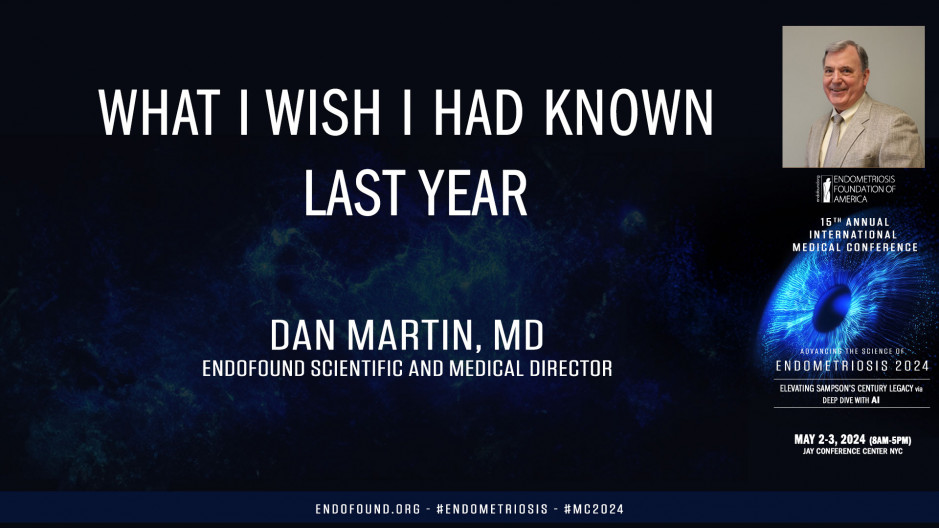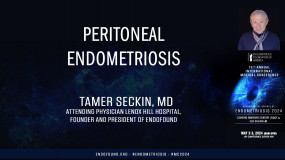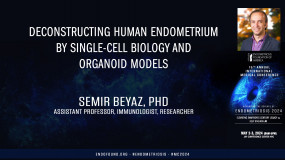International Medical Conference
Endometriosis 2024:
Elevating Sampson’s Century Legacy via
Deep Dive with AI
For the benefit of Endometriosis Foundation of America (EndoFound)
May 2-3, 2024 - JAY CENTER (Paris Room) - NYC
This is a good time to take a nap. This is my slide from three years ago when I did this talk at the American Society of Reproductive Medicine. So today it is going to be something up down. There we go. This is going to be what I wish I knew when I did that talk. This has to do with data and analysis. Since that talk, I have no disclosures. I will talk about the focus on this is going to be on data stating it is like Donna Vogel said in 2000 at the NIH, just like nailing jello to a tree. This comes and goes real quickly. We're not going to talk about the pain, neglect, confusion, all those things that go on with endometriosis. That list can be continued to more than a hundred different problems that endometriosis patients have. We're not going to talk about all the hundreds or sos of scientific challenges because those are all there.
We're going to look at data and some of that data as you understand is real squirrely, but we still have to look at all of that so we can decide where to go. This focus on specific concepts does not detract from the suffering of those with endometriosis After years of neglect, this focus to help us prepare to provide improved care, the concerns are, we talk about 10% of women have endometriosis as though that is an isolated number, but it's not an isolated number and it doesn't include everything I've got there. It just talks about infertility and pain predominantly. There are a few patients who presented with swelling for ovarian cyst with neither pain nor infertility, but that number is a fair small minority. The big numbers are pain and infertility. You can take the numbers for anywhere from 3.4 to 82% for infertility, 3.7 to 86% for pain.
So if you don't like my 5%, that's okay. I don't like 'em either. It is hard to get numbers that we can believe the numbers I'm using are because they fit what I saw in practice. So these are numbers that I believe are reasonable. Could we have other numbers? Of course we could. And when we look at that and look at all the ranges we deal not only with those two 5%, but there's 5.8% in Fuentes article and that top five points, 8% who are asymptomatic in Fuentes article becomes 15%. If you look at the focused figures in that one, so asymptomatic or probably the better word is coincidental because they weren't truly asymptomatic. Probably half of 'em had pain. Probably 10% of 'em had severe pain, but they did the same thing that I did when I had my bilateral pulmonary emboli. I ignored my shortness of breath for the first two days and ignored and told my wife that I was just tired. Didn't explain to her why I couldn't walk more than 20 feet. So she finally caught on. She told my son and within an hour I was in the emergency room. That's for shortness of breath and a 77-year-old male. When a woman comes in with her pain, with her menstrual pain and everything else and tells her mother, you don't get the response I got from my wife. You get, yeah, that's normal.
That's the difference in normalization of pain like chest pain in old men and pelvic pain in young women, chest pain in old men. You tell that to your son who's a physician, you go straight to the emergency room. If it's pelvic pain, you tell it to your mother, you get it's normal. So you get that thing. But what we do when we look at these concerns and so we narrow it down, we get to the point that we have about and of that 10%, about 1% is truly nonresponsive. Most everybody else we can treat with something, but that 1% is nonresponsive. And if we look at that, that 1% represents about 1.7 million women in the United States.
So we have 1.7 million women in the United States who are not going to respond to much of anything. So we need better answers for that. The 2% above that who respond to surgery, if you take the numbers down, it suggests that we need about 400. So if we define an expert, someone who does a hundred cases a year and we have 3.4 million women who need expert care and that's divided over 40 years by a hundred, you end up if we need somewhere between 400 and 1600 expert endometriosis surgeons and if we go for more than that, if we try to train everybody, we will have no experts. Remember, the more people you have who can do surgery, the fewer cases they get and the fewer experts you have. So watch out for what you asked for on this one. You may not want more people trained, you just may want better access. And that gets us to this point. Almost 50% of women don't have access and we have a major problem both in the United States and worldwide just on terms of access to care. If we look at the 20, oh boy, what happened to my slide?
Same thing that happened to mine when the graphs went away. This is interesting. 30 million women, 30 million people in the United States live in healthcare deserts don't have much access to anything. They travel seven to 12 hours for care. 43% of working class adults had inadequate health insurance in 2022, 46% skipped or delayed care because of the cost. So we have not only a problem in terms of getting people who have adequate care, adequate money, and if you look at some of the people who have come in like Pat nal who takes 10 or 12 years to get a diagnosis, who's got access to everybody? All she has to do is go up to a physician and they will jump and try to help her. So you have not only that problem, but you also have problems that there are those women who will not have access to care men and other things.
Then we get into people talk about repeat surgery. So that whole conversation this morning about what's management and what's treatment, I hate to tell everybody and I don't care who it is, but no matter whether you call it treatment or management's irrelevant, we don't have good treatment or good management and I think that if you're going to criticize one, you're going to criticize both and you can use either words, you won't, but we have troubles if we look at repeat surgery, and I hope this one doesn't scramble because there's going to be a lot of numbers. We have no definitive operation for endometriosis. I bring that up because I got slammed by the web trolls, okay? They thought I said we had one. I didn't say that what I failed to say, it wasn't what I said. It's what I didn't say. I followed an ACOG speaker who said we had a definitive one and what I should have done the minute I took over the speaker was disagree with them.
I didn't disagree with them. I went straight to my talk and therefore implicitly agreed with them. We don't have a definitive operation. Anybody who heard that talk and understands the debate, I did not want to say that. I don't think I said that. I think what I failed to do was give you the negative, but let's talk about the negative today. Basically our goals are going to be to treat symptoms and improve life for most women. If we look at the post cure rates, David loved this line talk about, remember they're talking about options. They're not talking about pain, they're talking about surgery and you see the, when you go back and they are ignoring the fact that I have a paper that last three or four pages of just different ways we could miss endometriosis of ro. That was this thing back here. If you want to read it, go to endometriosis concepts.com and you'll find it's in there. So this is, if we look specifically at papers that we have, the paper by federal and Italy showed that the reoperation or GN H treatment, that young patients with 54% down to zero at 35. But if instead of looking at severe pain, if you look at just recurrence of pain coming back to seeing patients, then the numbers and the 35, 31, 35 range, you jumped by threefold.
If we take that and look at the Ontario Health database, 84,000 patients, 43 life philosophies, thousand. They provided that into six different groups. We're going to look at three outcomes we're look at diagnostic laparoscopy and therapeutic oscopy without vs. O because you take out the opiates, almost nobody has surgery. And we're going to look at discectomy with VSO, which is supposed to be definitive. We're going to look at those at these three groups. Remember that asterisk means they preserved the therapeutic preservation. The disclaimer in the beginning, remember this is going all physicians together. If you look at stalls data at the 25th percentile, once a patient can get to a gynecologist, takes 'em a month to make the diagnosis. 25% of gynecologist at the 50th percentile is five months. At the 75th percentile is 32 months. Their average delayed diagnosis was 8.3 years. Family physicians with all the people in between the patients and physicians who held up the most patients held themselves up somewhat because of the same reason I talked about earlier. Everybody normalizes everything, okay? Even crazy people like me and my brother with his MBO embolism up in St. Louis and drove to Atlanta. So you can see a surgeon in Georgia trouble, well, Missouri is the Yankee.
So we're going to look at that database. If you only look at repeat surgery, then hysterectomies 4.4% compared to 24%. Note that that 24% for diagnostic oscopy means that 75.8% of women who had a diagnostic laparoscopy only did not have more surgery. That suggests that either several things. One is with the diagnosis, the patient can handle it better. Two is with the diagnosis, the physician to handle it better. Three is our data is a piece of trash and go to go find better data making a choice. Probably others I'm not going to talk about. But if you look at the ER visits for pain, then hysterectomy doesn't look so good. There's only a 7% difference between laparoscopies and ectomy in terms of repeat visits for pain. And if you look at any visit for pain, that gets even worse. It's only 5% difference. So in terms of coding for pain, diagnostic and therapeutic velocity were fairly equivalent and hysterectomy was only about 5% better. So if you're looking at pain instead of repeat surgery rates, we don't do so well. That's the reason for those whatsoever. Everybody's unhappy about Andrew horn's study, Andrew Horn, Lucy Whitaker, and Scott McKenzie and a whole bunch of others. If you haven't read the whole list, you see my name on there somewhere.
There are three of us at my level who are the blinded reviewers for the surgery. So I'm a blinded reviewer in that setting. The other two are my level. So Andrea has gone in there and decided they have a three arm study. They have excision, coagulation, or laser ablation, depends on the preferences of the surgeon and a no treatment arm. How in the world they have not had 500 plus patients who signed the permit. How do they get 500 patients to sign a permit that says they're not going to treat 'em. It's beyond me. But so far they've done it. So we're waiting to see if they can show the differences. Next step. If we look at reoperation rates, the color came off, the color was on my numbers. If you notice on there, I have both the highest and the lowest reoperation rates have the highest reoperation rates in 20 kids and the lowest and over makes it look like this is a biologic problem.
This isn't operator defendant. This bothers you of disease. Here you operate on somebody more chance. And I think Shavas article, the best data out there, mine is kind of quasi and youngs, as you understand, his 47% had for repeated surgery. He didn't see any endometriosis in anybody. But when I talked to him about it, he has no idea whether he can see foundation or not. He no idea of what I talked about. I was talking about visualization. Doesn't know why he should calibrate his instrument. So when he says he doesn't see anything, I don't dunno if he knows what he see.
If we look at repeat surgery rates, they increase over time. More specifically, most ally, far Roman has head from 11%, 23% to 28% in 10 years. The latest recurrence I had was at 17 years and somebody whose first operation was 24 years from the last one. Her first one was for nephrectomy, for renal death, and she would reshape her rectal endometriosis to avoid ostomy and she kept getting recurrences right before we shake. So these aren't recurrences, this is persistence of what I left on every single one of them. Not new endometriosis but old endometriosis. In David study of 35 patients who have either repeat operations on 33 or 35, where in areas he had treated. And most of 'em when you look back and can see what they were from the previous problem, the biggest, biggest problem in mind were tunnel location plus. If you just look at the tertiary centers and the RY centers, the more deep endometriosis you handle, the better your pal looks. And that's the same thing my patients had. Big, large nodules respond to surgery, diffuse nodules. If somebody has diffuse pain, respond to surgery. The focal endometriosis and diffuse pain is a nonsurgical decision. I wish I kept the numbers. Statistics on that observation. If we have our time, one section.










